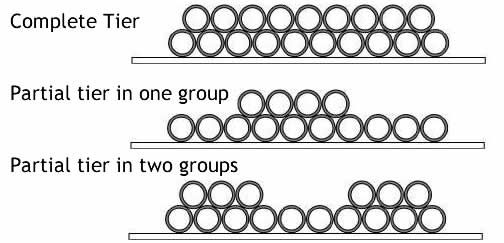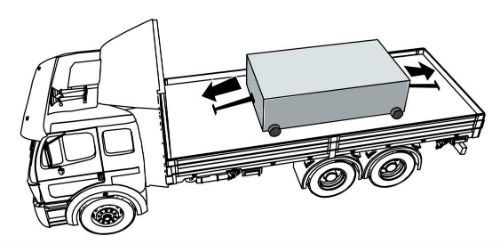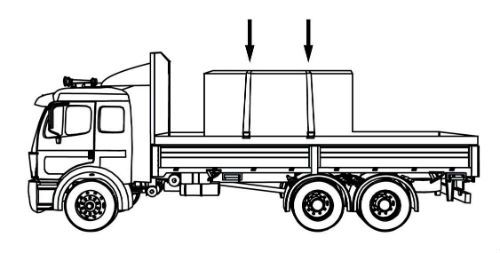CDL Practice Tests: Flatbed Cargo Securement
Choose A Section:
Go!When securing concrete pipe loaded crosswise, arrange the top tier:
- As a partial tier in two groups.
- Any of these are acceptable.
- As a partial tier in one group.
- As a complete tier.
Requirements for arranging the top tier

Arrange the top tier as a complete tier, a partial tier in one group, or a partial tier in two groups.
What is the minimum aggregate WLL of all tiedowns in a group of concrete pipe?
- 80% of the total weight of all pipes in the group.
- It depends on the size of the pipe.
- 5,000 lbs.
- More than 50% of the total weight of all pipes in the group.
General tiedown requirements
The aggregate working load limit of all tiedowns on any group of pipe must be more than half the total weight of all pipes in the group.
Which of the following are not covered by the specific log securement requirements?
- None of these are covered by the specific log requirements
- Logs unitized by banding or other comparable means.
- Firewood, stumps, debris, other short logs, and longer logs.
- Loads of no more than four processed logs.
The following types of logs are not covered by the specific logs requirements:
- Logs unitized by banding or other comparable means. [Secure according to general cargo securement requirements.]
- Loads of no more than four processed logs. [Secure according to general cargo securement requirements.]
- Firewood, stumps, debris, other short logs, and longer logs. [Transport in a vehicle or container enclosed on both sides, the front, and the rear and strong enough to contain them.]
What is the minimum weight of a shipment of paper rolls that would require specific securement requirements?
- 2,268 lbs
- 10,000 lbs
- It depends on how they're loaded
- 5,000 lbs
The rules in this section apply to shipments of paper rolls, which individually or together, weigh 2268 kg (5000 lb.) or more.
Note: Shipments of paper rolls that weigh less than 2268 kg (5000 lb.), and paper rolls that are unitized on a pallet may either be secured in accordance this section or with the general cargo securement requirements
When loaded cement pipe over 45 inches in diameter, which pipes should be blocked, wedged, or otherwise immobilized?
- Front and rear.
- Front only.
- Rear only.
- It depends on the weight of the load.
Immobilize the front and rear pipe with on of the following methods:
- Blocking
- Wedges
- Vehicle end structure
- Stakes
- Locked pipe unloader
- Other equivalent means
Requirements for securing heavy vehicles, equipment, and machinery apply at what weight?
- More than 4,500 lbs
- Less than 10,000 lbs
- 50% the weight of the trailer
- More than 10,000 lbs
What Does This Section Cover?
The requirements in this section apply to the transportation of heavy vehicles, equipment, and machinery that:
- Operate on wheels or tracks, such as front end loaders, bulldozers, tractors, and power shovels.
- Individually weigh more than 4500 kg (10,000 lb.).
When securing metal coils with eyes vertical, the angle between tiedown and deck, if possible, should be:
- Less than 45 degrees
- 180 degrees
- 60 degrees
- Between 60 and 90 degrees
- Attach at least one tiedown against front of row of coils to restrain against forward motion. If possible, angle between tiedown and deck should be less than 45, when viewed from the side of the vehicle.
- Attach at least one tiedown against rear of row of coils to restrain against rearward motion. If possible, angle between tiedown and deck should be less than 45, when viewed from the side of the vehicle.
- Attach at least one tiedown over top of each coil or side-by-side row of coils to restrain against vertical motion. Tiedowns going over top of coil(s) must be as close as possible to eye of coil.
- Arrange tiedowns, blocking, or bracing to prevent shifting or tipping in all directions.
Within the requirements for concrete pipe, which of these requires specific securement methods?
- Concrete pipe loaded in a sided vehicle or container.
- Concrete pipe loaded cross-wise on a flatbed trailer.
- Concrete pipe eyes vertical and concrete pipe loaded lengthwise.
- Concrete pipe that is grouped together into a single rigid article and may not roll.
What is exempt from these specific requirements?
Follow general cargo securement requirements (Section 2) when transporting the following pipe:
- Concrete pipe that is grouped together into a single rigid article and may not roll.
- Concrete pipe loaded in a sided vehicle or container.
- Concrete pipe eyes vertical and concrete pipe loaded lengthwise.
What is covered under these specific requirements?
Any concrete pipe loaded crosswise on a platform trailer or vehicle that is not exempt.
When securing metal coils, it is acceptable to use nailed blocking or cleats as the sole means to secure:
- It is not acceptable.
- Chocks
- Timbers
- Nailed wood cradles
The use of nailed blocking or cleats as the sole means to secure timbers, chocks or wedges, or a nailed wood cradle, is prohibited.
The aggregate WLL for logs loaded lengthwise must be at least:
- 1/2 the weight of the stack.
- 1/2 the weight of the load.
- 4,000 lbs
- 1/6 the weight of the stack.
Working load limit for longwood and shortwood loaded lengthwise
The aggregate working load limit for all tiedowns must be no less than 1/6 the weight of the stack of logs.
Note: This requirement is much less than the general requirement of an aggregate working load limit equal to 1/2 the weight of the load. This lowered requirement recognizes that the bunks/stakes help to prevent slippage.
About The Flatbed Cargo Securement CDL Manual
Studying the flatbed cargo securement CDL manual is not a requirement for getting your CDL permit or license. It is required knowledge for flatbed drivers.
Some questions you should be able to answer for flatbed cargo securement:
- What is the minimum Working Load Limit of a tiedown used to secure logs?
- What is the minimum weight of a shipment of paper rolls that would require specific securement requirements?
- When securing concrete pipe over 45 inches loaded crosswise, which direction must the tiedowns on the front half of the load run?
- What is a cab shield?
- When securing concrete pipe over 45 inches loaded crosswise, which direction must the tiedowns on the rear half of the load run?
- What is a dunnage bag?
- Who is responsible for inspecting securing devices and cargo within the first 50 miles?
- How many tiedowns are required on a stack of shortwood loaded crosswise?
- What is the minimum working load limit of each tiedown used to secure crushed or flattened vehicles?
- Define 'bolster'
- What is a hook-lift container?
- When a tiedown is attached directly to the cargo, what is the ideal angle where it attached to the vehicle?
What is a securing device?
Any device specifically manufactured to attach or secure cargo to a vehicle or trailer:
- Synthetic Webbing
- Chain
- Wire rope
- Manila rope
- Synthetic rope
- Steel strapping
- Clamps and latches
- Blocking
- Front-end structure
- Grab hooks
- Binders
- Shackles
- Winches
- Stake pockets
- D-rings
- Webbing ratchet
- Bracing
- Friction mat
What is a tiedown?
A combination of securing devices that forms an assembly that:
- Attaches cargo to, or restrains cargo on a vehicle.
- Is attached to anchor point(s).

Some tiedowns are attached to the cargo and provide direct resistance to restrain the cargo from movement.

Some tie-downs pass over or through the cargo. They create a downward force that increases the effect of friction between the cargo and the deck. This friction restrains the cargo.
 Related Cargo Securement Terms That Every Driver Should Know:
Related Cargo Securement Terms That Every Driver Should Know:
-
Tiedown:
A combination of securing devices which form an assembly that attaches cargo to, or restrains cargo on, a vehicle or trailer, and is attached to anchor point(s).
-
Contained:
Cargo is contained if it fills a sided vehicle, and every article is in contact with or sufficiently close to a wall or other articles so that it cannot shift or tip if those other articles are also unable to shift or tip.
-
Blocking:
A structure, device, or another substantial article placed against or around an article to prevent horizontal movement of the article.
How should tiedowns be attached?
Tiedowns can be used in two ways:
-
Attached to the cargo:
- Tiedowns attached to the vehicle and attached to the cargo.
- Tiedowns attached to the vehicle, pass through or aroundan article of cargo, and then are attached to the vehicle again.
-
Pass over the cargo:
- Tiedowns attached to the vehicle, passed over the cargo, and then attached to the vehicle again.
Tiedown placement:

Place the tiedown as close as possible to the spacer.
Position the tiedowns as symetrically as possible over the length of the article.

Position the tiedowns to preserve the integrity of the article.







 TT On Facebook
TT On Facebook